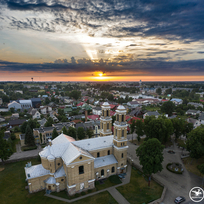During the time of the Grand Duchy of Lithuania, Vievis was a manor, but it is not known when it was founded. The first surviving inventory of the manor is December 17, 1577. The inventory notes that there is an old dilapidated church near Vievis, empty, without paintings and other cult facilities, with broken doors. There is no real knowledge when and who built it. It will probably have appeared at the manor in the 15th century. pab. or the 16th c. pr. About 1600 one of the Oginskis built a church for Unites in Vievis and a monastery. The church in 1794. burned. 1796 built new as well as wooden. (= 1810-05-16 By the order of the synod, the monastery was closed and the land and its peasants were assigned to the Orthodox secular parish. The priests were paid an annual salary of 80 rb; The church, which had been abducted by the Russians, was burnt down by the French in 1812. The services were moved to the Strėvininkai Catholic Church, which was later moved to Aukštadvaris. Gabriel Oginskis built a new church for Catholics in Vievis in 1816. The church was completely repaired by the townspeople and Father J. Mincevičius between 1911 and 1931. The beautiful, high brick church was built of white bricks.
There was an old chapel in Vievis cemetery, it is not known whose year it was built. Next to the graveyard, in the garden, stood an old rectory, which, according to people’s accounts, in 1812. Napoleon spent the night. Residents of Vievis area are Lithuanians; however, the landowners were bent over and made every effort to bend the Lithuanians. It would have been all bent, if not for the persistent Lithuanians (J. Milančius, M. Grybauskas and others). 1905 A Lithuanian priest was brought from Vilnius to Vievis, who, while visiting the people of the parish, also distributed Lithuanian writings. The pastor of Vievis did not like it very much, Fr. To Verpuchovsky. The conflict over Lithuanian and Polish worship in Vievis Church continued for a long time. In the church for two consecutive Sundays and during all annual holidays, services were held in Polish. Lithuanian services were held only every third Sunday. Lithuanians felt offended. Local servants and other citizens approached the pastor J. Mincevičius to introduce this Lithuanian service with the Poles in half, ie on equal terms. But the pastor didn’t even want to talk about it. Only Polish was spoken in the rectory, and the regular guests of the pastor J. Mincevičius were various overthrown landowners interested in holding Polish services in the church. Without agreeing with the pastor on Lithuanian services, the people turned to the bishop, and when he did not help anyone, they turned to the head of Vievis. After the population census, it became clear that the majority of Lithuanians in Vievis. The request to increase the number of Lithuanian services was submitted to the bishop with the above-mentioned lists. Based on it, the bishop introduced services two Sundays in a row and all annual holidays in Lithuanian, and left Polish services every third Sunday. The pastor J. Mincevičius was dissatisfied, he was angry with the bishop about it, but the new order was not revoked. The church continued to be improved. It is a neo-baroque church with elements of classicism, a plan of the Latin cross, a basilica with two-storey facade towers. Vievis Church is decorated with three cultural monuments: two easel paintings “Marija Rožančinė”, “St. Cecilia ”and the sculpture The Crucified.
In the cemetery of the church, Fr. J. Mincevičius and vicarage P. Budrauskas, Č. Kavaliauskas and Fr. altarist R. Šalčiūnas.
From. aut. Augenis Kasputis, Dronoteka




Reviews